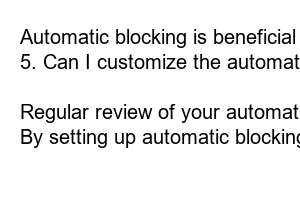보안 위험 자동 차단 설정
Title: The Ultimate Guide to Setting Up Automatic Blocking of Security Risks
Introduction:
Protecting your online presence is of paramount importance, especially in today’s digital landscape where security threats are rampant. One effective way to bolster your security measures is by setting up automatic blocking of security risks. In this comprehensive guide, we will walk you through the entire process, offering insight into its significance and how to implement it seamlessly.
1. Understanding the Importance of Automatic Blocking:
By automating the process of blocking potential security risks, you can safeguard your website, data, and reputation in real-time. This proactive approach ensures that you are constantly staying one step ahead of cyber threats.
2. Assessing Your Security Needs:
Before setting up automatic blocking, it is crucial to evaluate your unique security needs. Consider factors such as the sensitivity of your data, the extent of potential risks, and the impact of a security breach. This assessment will help determine the level of automation required.
3. Identifying Common Security Risks:
To effectively block security risks automatically, it is essential to familiarize yourself with the most prevalent threats. This includes malware attacks, brute force attempts, SQL injections, and distributed denial-of-service (DDoS) attacks. Understanding these risks will allow you to tailor your security measures accordingly.
4. Selecting the Right Security Solution:
Choose a reputable security solution that offers automatic blocking functionalities. Look for features such as real-time scanning, intelligent threat detection algorithms, and comprehensive reporting. This ensures that your chosen solution aligns with your specific security needs.
5. Configuring Automatic Blocking Mechanisms:
Once you have selected your security solution, configure its automatic blocking mechanisms. Fine-tune settings to address specific risks and determine the severity threshold that triggers automatic blocks. By doing so, you can strike a balance between robust protection and minimizing false positives.
6. Monitoring and Regular Fine-tuning:
While automatic blocking provides a significant layer of protection, it is crucial to monitor its effectiveness regularly. Analyze reports and logs to identify any areas of improvement or potential false positives. Tweak settings or adjust the algorithm to optimize your security measures continually.
7. Ensuring Compatibility with Other Security Tools:
Consider the compatibility of your automatic blocking solution with other security tools you have in place. Integration with firewalls, intrusion detection systems, and content delivery networks can enhance the overall effectiveness of your security measures.
Summary:
Setting up automatic blocking of security risks acts as a powerful shield against the ever-evolving landscape of online threats. By understanding its importance, assessing your specific needs, and selecting the right security solution, you can establish a robust defense mechanism. Configure and fine-tune the automatic blocking mechanisms, monitor their effectiveness consistently, and ensure compatibility with other security tools for comprehensive protection.
FAQs:
1. Can automatic blocking prevent all security risks?
While automatic blocking is a proactive and effective security measure, it cannot guarantee absolute protection from all risks. Regular monitoring, updates, and a multi-layered security approach are essential for comprehensive protection.
2. What are false positives, and how can they be minimized?
False positives occur when legitimate traffic or actions are wrongly identified as security risks and blocked. Minimize false positives by fine-tuning your automatic blocking thresholds and regularly reviewing reports and logs.
3. Can automatic blocking slow down website performance?
When implemented correctly, automatic blocking should not significantly impact website performance. Choose a security solution that is optimized for speed and efficiency to minimize any potential delays.
4. Is automatic blocking suitable for all types of websites?
Automatic blocking is beneficial for all types of websites, regardless of their size or industry. Cybersecurity threats are ubiquitous, making it essential to have robust protection in place for every online entity.
5. Can I customize the automatic blocking rules according to my needs?
Yes, most security solutions allow for customization of automatic blocking rules. You can tailor these rules to match the specific security requirements of your website.
6. How frequently should I review my automatic blocking settings?
Regular review of your automatic blocking settings is recommended, typically on a monthly basis. However, if you notice any unusual activity or encounter a security breach, perform an immediate review to enhance protection.
By setting up automatic blocking of security risks, you can fortify your online security, protect your data, and maintain the integrity of your website. Stay vigilant, regularly fine-tune your settings, and integrate multiple security tools to maximize your defense against evolving cyber threats.

